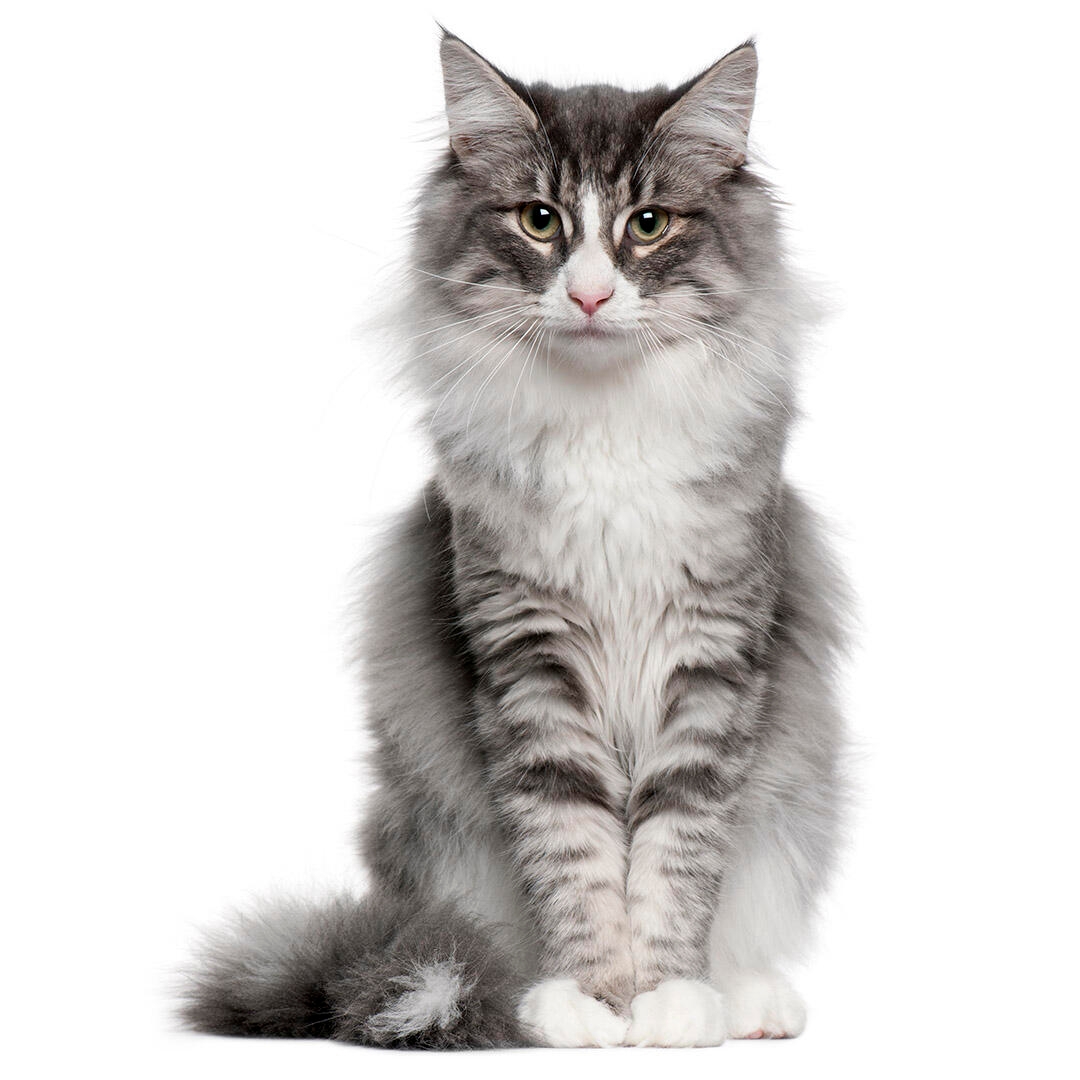
| Family-friendly: | 2/5 |
| Playfulness: | 3/5 |
| Intelligence: | 3/5 |
| Tendency to Vocalise: | 4/5 |
| Likes Other Pets: | 4/5 |
| Grooming needs: | 4/5 |
| Shedding: | 4/5 |
The Norwegian Forest cat breed can be prone to:
- Hypertrophic cardiomyopathy¹ which is a disease were the heart muscle becomes abnormally thick which means the heart cannot beat effectively.
- Pyruvate kinase deficiency which is a disease that causes anaemia (death of red blood cells).
- Glycogen storage deficiency which is a serious storage disease that affects the heart, nerves and muscles.
Testing available:
- DNA testing for pyruvate kinase deficiency and glycogen storage deficiency which tests whether or not a cat has the potential to be affected by these conditions.
¹K. M. Meurs et al, 'Analysis of 8 Sarcomeric Candidate Genes for Feline Hypertrophic Cardiomyopathy Mutations in Cats with Hypertrophic Cardiomyopathy', 2009, Journal of Veterinary Internal Medicine
Larger than the average cat, the Norwegian Forest is both elegant and muscular, with a robust build and a glorious semi-long coat. Strongly and solid, they have a long, triangular head with high set, tufted ears, long legs, and a majestic bushy tail. Coats are semi-long, with the body fur shedding out to a shorter length in summer. The winter coat sports a full ruff around the neck, shirtfront, and fluffy trousers around the hind legs.
Gentle and friendly, but not constantly demanding of attention, a Norwegian Forest cat or ‘Wegie’ is happy to entertain themselves if no one is home, and equally satisfied with curling up beside their people when they are there. The Norwegian Forest cat temperament can be somewhat reserved, when it comes to visitors, and are not particularly lap-cats (often because they can be prone to overheating) but will enjoy affection and physical contact from their people.
| Family-friendly: | 2/5 |
| Playfulness: | 3/5 |
| Intelligence: | 3/5 |
| Tendency to Vocalise: | 4/5 |
| Likes Other Pets: | 4/5 |
| Grooming needs: | 4/5 |
| Shedding: | 4/5 |
Believed to originate in Scandinavia and referred to as the Skogkatt in its homelands, the Norwegian Forest Cat is mentioned in Viking legend and mythology. Their wild and rugged appearance, with a sturdy build and thick, weatherproof coat means these cats would easily have coped with the Scandinavian climate, and with traveling as ships cats. At risk of dying out in the early 20th Century, breeders worked hard to save them, putting in place a special breeding program in the 1970s to protect the breed. They received royal recognition from King Olaf, who designated them the official cat of Norway!
Highly suited to spending time outdoors, the Norwegian Forest cat loves climbing, and isn’t shy of coming head first down tree trunks and fencing. A secure cat-proof fence should be used around any outdoor space your Norwegian Forest cat has access to, or consider an enclosed run. Very suited to farm life, a Norwegian Forest cat would be more than happy to patrol haybarns and feed rooms during the day, and curl up on the sofa at night.
This is an athletic and outgoing cat who will enjoy climbing and will need cat trees and furniture that allows an outlet for this behaviour. Although easy going and not particularly demanding, the Norwegian Forest cat does enjoy a good game, and it should be easy to devise ways to play, and have your cat work for their food via food dispensing toys that replicate parts of the hunting sequence. This also helps with their tendency for weight gain.
Every cat is unique and each has their own particular likes, dislikes, and needs when it comes to food. However, cats are carnivores and every cat must obtain 41 different and specific nutrients from their food. The proportion of these nutrients will vary depending on age, lifestyle and overall health, so it's not surprising that a growing, energetic kitten needs a different balance of nutrients in her diet than a less active senior cat. Other considerations to bear in mind are feeding the right quantity of food to maintain 'ideal body condition' in accordance with feeding guidelines and catering to individual preference regarding wet or dry food recipes. With proper nutrition and care, the Norwegian Forest cat lifespan can extend to 15 years.
The adult cat will require a general groom once a week, however kittens and elderly cats may require daily grooming to ensure the coat is clean and tangle free. This heaviest Norwegian Forest cat shedding period is in spring – brushing well at this time can help speed up the process. A weekly groom gives you the opportunity to check the coat for parasites and any minor injuries.
For the quiet and patient family, the Norwegian Forest cat can make an excellent companion. They are slow to mature and can be shy and reserved so may not suit a very boisterous family or on with a constant stream of guests, but are otherwise a good match for most homes.
Yes, they can be excellent pets as they usually get along great with children and other pets so they should have no problems integrating in a new family.
The Norwegian Forest cat personality is sweet, easy going, and sociable, but they also really enjoy their alone time, so they don’t require too much attention and entertainment.
The Norwegian Forest cat size is quite large, so they do appreciate big spaces and adore roaming around in the great outdoors. But this is not a mandatory requirement as they’re also highly adaptable and can adjust rapidly to any environment.
In terms of size, the Norwegian Forest cat size is between 30 and 46 cm while the Main Coon cat measures between 48 and 100 cm so yes, the Main Coon cat is definitely bigger than the Norwegian Forest.